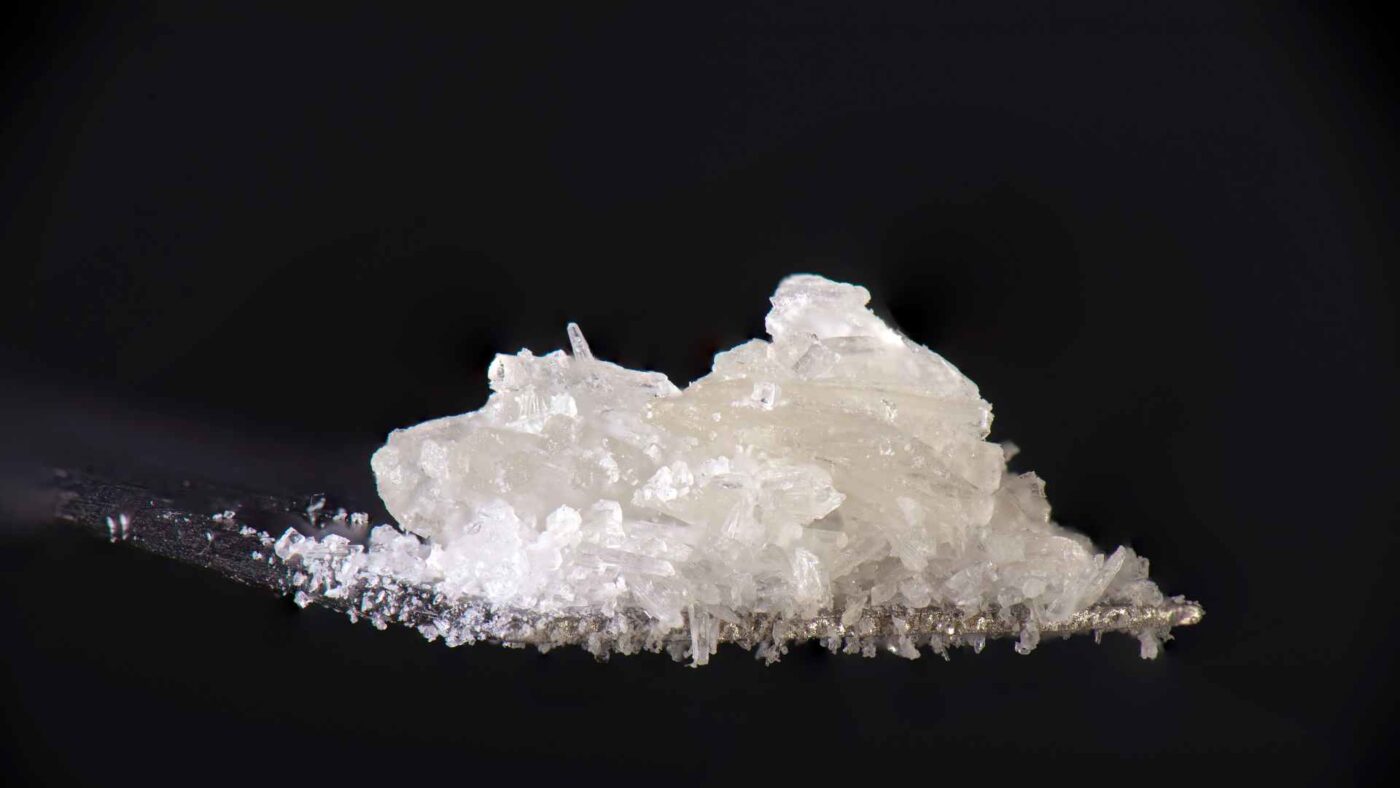HEALTH /SCIENCE
How is Cannabis Isolate Made?
Learn the step by step process to make the beloved 99.9% pure cannabis used in most edibles, topicals, and more.

You may not have heard of cannabis isolate, but if you’ve ever eaten an edible, taken cannabis in pill form, or used a THC topical, you’ve likely consumed it. Isolate, whether THC, CBD, or another cannabinoid, is a foundation of the modern cannabis industry. It’s also a fascinating product that is produced using state-of–the-art industrial chemical processing equipment with plenty of fun, complex names. So strap on your lab goggles, and let’s dig in.
What is Cannabis Isolate?
Cannabis isolate is a form of THC that’s been isolated into either a crystal or powder form and contains around 99% pure THC.

THC isolate is one of the most valued products in the cannabis industry. Photo credit: Shutterstock
All the other plant matter like waxes, fats, and terpenes have been removed from the final product, which means that THC isolate is flavorless unless the extraction technicians add terpenes back in. This often happens when creating products like vape cartridges or certain concentrates. Typically, edible makers are more interested in using the flavorless cannabis isolate, because they can add potency without a weedy taste.
Why is Cannabis Isolate Used?
An issue when it comes to making any cannabis product, from edibles to medical-grade pills, is consistency. Cannabinoid content and terpene profiles vary from strain to strain, and even from harvest to harvest. That can make it hard to know the exact dosages of a product without rigorous and time-consuming testing beforehand. Because THC isolate is tasteless, odorless, and nearly pure THC, it makes it much easier to measure out for dosing. The math is simple: one milligram of pure isolate is one milligram of THC. That means that if you’re an edibles manufacturer, a cannabis lotion company, or you make vape cartridges, there’s no guessing as to how much THC your product contains. This is especially important when it comes to edibles, or any product where having more than the legal amount of THC in your product (say 12mg per dose instead of 10mg) can get you shut down by your state cannabis control board. That’s why isolate is so widely used in cannabis products across the industry. These same qualities make it attractive to many cannabis consumers as well, who favor isolate for its easy dosing, consistency, and lack of smell.
How is Cannabis Isolate Made?
Unlike other types of cannabis concentrates, which can be created at home, making cannabis isolate requires some pretty expensive lab necessities such as centrifugal partition chromatography equipment and some very impressive lab coats.

Making cannabis isolate requires some big lab equipment. Photo credit: Shutterstock
Basically, the extraction technicians creating THC isolate are trying to remove all the hundred or so minor cannabinoids, terpenes, flavonoids, and other compounds found on cannabis plant matter. In other words, getting rid of everything that isn’t THC. This creates a final product that’s basically a crystal of pure THC. But how is it done? Lower your lab goggles (told you they’d come in handy) and let’s get into it.
Step 1: Extraction
The first step to creating cannabis isolate is pretty much the same as making any solvent-based cannabis concentrate: extraction of the cannabinoids and terpenes from the plant matter. While this can be done using a number of alcohol or hydrocarbon-based solvents, from isopropyl alcohol to butane, the gold standard of the industry is using supercritical CO2 extraction. This method is the most pricey and requires specialized industrial equipment, but it’s the most effective when it comes time to remove the residual solvents from the concentrate. In other words, it creates the purest product which is preferred by both manufacturers and consumers.
 A closed loop system is often used to create cannabis isolate. Photo credit: Shutterstock
A closed loop system is often used to create cannabis isolate. Photo credit: Shutterstock
In supercritical CO2 extraction, technicians use a closed-loop system to cool CO2 to -68.8 Fahrenheit while bumping up the pressure inside the chamber to 75psi. This causes the CO2 to become “supercritical” (referring to the state of matter, not that the CO2 gets really judgy). The CO2 now exists between a liquid and gaseous state. This makes it an excellent solvent when passed through the chamber over the plant matter, extracting all the cannabinoids and terpenes and leaving behind the fats, waxes, chlorophyll, and other unwanted plant substances.
Continue Reading Below
Step 2: Winterization
Now that the cannabinoids and terpenes have been extracted from the plant matter, it’s time to remove the rest of the unwanted materials. To do this, the raw concentrate is washed with ethanol, then placed overnight in a freezer. This causes the lipids (aka fats and waxes) to rise to the top of the concentrate and congeal together.
Step 3: Filtration
The crude concentrate is removed from the freezer, then run through a filtration system. This separates the coagulated lipids and other materials from the cannabis oil. This is done as many times as needed until the oil is pure.
Step 4: Removing the Ethanol

A rotary evaporator helps evaporate the alcohol and leaves the oil. Photo credit: Shutterstock
Now that the oil’s been filtered, it’s time to remove the ethanol by putting it through a rotary evaporator. A rotary evaporator gradually warms the mixture. Because alcohol boils at a lower temperature than oil, it evaporates from the mixture before the oil does. Once the alcohol has boiled off, it’s collected in a condenser for reuse in other extractions.
Step 5: THC Isolation
From there, the THC in the oil is decarboxylated if this wasn’t done prior to extraction. Either way, the decarboxylated oil is distilled using “Short Path” or “Fractional” distillation. This distillation method uses thermal heating, which siphons off different cannabis compounds as they reach their specific boiling points, including THC. Once the THC has been isolated from the rest of the compounds, it can be extracted into THC crystals. These crystals can be quite large, which is why they are often referred to as diamonds, or they can be pulverized into a pure white isolate powder.
Cannabis Isolate vs. Distillate
So what’s the difference when it comes to isolate vs. distillate? You can think of distillate as the precursor to isolate. Like isolate, distillate begins as a cannabis concentrate that is then further purified of compounds like terpenes by using the same boiling point techniques.

Distillate goes through almost the same process, but doesn’t boil off the oil. Photo credit: Shutterstock
However, the end result of distillate is a transparent, sap-like cannabis oil with pure (or nearly pure) THC. However, it will still contain a certain portion of lipids (fat compounds). Isolate is simply taken through additional steps to change its form and remove these final lipids. Distillate still counts as a hash oil, and can be dabbed. Isolate is a pure THC crystal or powder with no oil left in it. Isolate can also technically be dabbed, but this usually isn’t done without at least some small portion of terpenes added.
The Wrap Up
Cannabis Isolate is an integral part of many cannabis products. It allows for precise dosing of THC. It’s also a fascinating process of just how much modern science goes into a product made from one of the oldest domesticated plants.
Frequently Asked Questions
How is Isolate Powder Made?
Using a series of steps of both heating and freezing, cannabis concentrate is purified of all the waxes, lipids, terpenes, and other compounds until only crystallized THC remains.
What are Isolates in Cannabis?
Isolates are purified products that contain only one cannabinoid like THC. They naturally form crystals, but are usually then ground down into a fine white powder. Isolate is used to accurately and consistently dose cannabis products like edibles.
Is Isolate Synthetic?
Isolate is not synthetic. It’s THC that’s been distilled and extracted from organic plant matter into a purified crystal form.
Never miss another story
Subscribe to our newsletter to stay up to date with the latest Cannabis News SUBSCRIBE This site is protected by reCAPTCHA and the Google Privacy Policy and Terms of Service apply.
What is the Difference Between Isolate and Distillate?
Isolate is a crystal or powder that’s pure THC or CBD (or whatever cannabinoid was required), without terpenes or any other plant matter. Distillate is a sap-like oil that’s had the terpenes and other non-cannabinoid compounds filtered out, but is still in liquid form.
